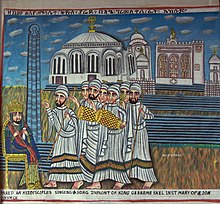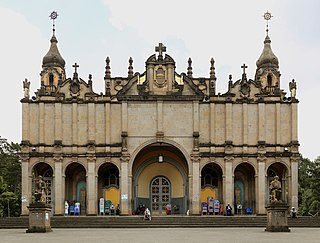
The Ethiopian Orthodox Tewahedo Church is the largest of the Oriental Orthodox Churches. One of the few Christian churches in sub-Saharan Africa originating before European colonization of the continent, the Ethiopian Orthodox Tewahedo Church dates back to the acceptance of Christianity by the Kingdom of Aksum in 330, and has between 36 million and 49.8 million adherents in Ethiopia. It is a founding member of the World Council of Churches. The Ethiopian Orthodox Tewahedo Church is in communion with the other Oriental Orthodox churches.
Ethiopian music is a term that can mean any music of Ethiopian origin, however, often it is applied to a genre, a distinct modal system that is pentatonic, with characteristically long intervals between some notes.
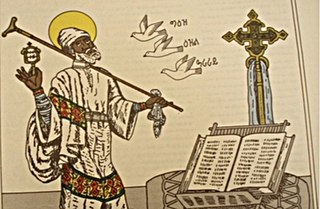
Saint Yared was an Aksumite composer in the 6th century. Often credited with the forerunner of traditional music of Ethiopia and Eritrea, he developed the music of the Ethiopian Orthodox Church and Eritrean Orthodox Church, in broder context the Coptic Orthodox Church and Syriac Orthodox Church the use in liturgical music, as well as the Ethiopian musical notation system. Additionally, he composed Zema, or the chant tradition of Ethiopia, particularly the chants of the Ethiopian-Eritrean Orthodox Tewahedo Churches, which are still performed today.

Tabot is a Ge'ez word referring to a replica of the Tablets of Law, onto which the Biblical Ten Commandments were inscribed, used in the practices of Orthodox Tewahedo Christians in the Ethiopian Orthodox Church and Eritrean Orthodox Church. Tabot can also refer to a replica of the Ark of the Covenant. The word tsellat refers only to a replica of the Tablets, but is less commonly used.
Ejigayehu Shibabaw, known by her stage name Gigi, is an Ethiopian singer. She has performed the music of Ethiopia in combination with a wide variety of other genres, often in collaboration with her husband Bill Laswell, a bassist and producer.

The culture of Ethiopia is diverse and generally structured along ethnolinguistic lines. The country's Oromo-speaking majority adhere to an amalgamation of traditions that were developed independently and through interaction with neighboring and far away civilizations, including other parts of Kenya, Sudan, Egypt, and other parts in East Africa. By contrast, the nation's Nilotic communities and other ethnolinguistic minorities tend to practice customs more closely linked with South Sudan and/or the African Great Lakes region.

The Ethiopian Catholic Church or Ethiopian Eastern Catholic Church is a sui iuris (autonomous) Eastern Catholic church that is based in Ethiopia. As a particular church of the Catholic Church, it is in full communion with the Holy See. Established in 1930, the church is organised under a metropolitan bishop who exercises oversight of a number suffragan dioceses. In its liturgical services, it uses the Alexandrian Rite in the Ge'ez language.

A kebero is a double-headed, conical hand drum used in the traditional music of Eritrea, Sudan and Ethiopia. A piece of animal hide is stretched over each end of the instrument, thus forming a membranophone. A large version of the kebero is also used in Ethiopian and Eritrean Orthodox Christian liturgical music, while smaller versions are used in secular celebrations. The kebero is primarily used in weddings, funerals and other ceremonies. The instrument is made from the hollowed out section of a tree trunk and then hard particles are inserted into it. The shell is then covered with two cow leather membranes, so that one can be tuned higher than the other. A kebero is also used in a worship called wereb. It is mostly done in Eritrea and Ethiopia.
Ethiopian Americans are Americans of Ethiopian descent, as well as individuals of American and Ethiopian ancestry. The largest Ethiopian American community is in the Washington, D.C. metropolitan area, with some estimates claiming a population of over 200,000 in the area; other large Ethiopian communities are found in Minneapolis–Saint Paul, Las Vegas, Seattle-Tacoma-Bellevue, Denver, the San Francisco Bay Area, Los Angeles, Salt Lake City, Columbus, andSouth Dakota.

Christianity in Ethiopia is the country's largest religion with members making up 59% of the population.

Eritrea as a country and the Eritrean community are multi-religious. Eritrea has two dominant religions, Christianity and Islam.
Peter Jeffery is an American musicologist.
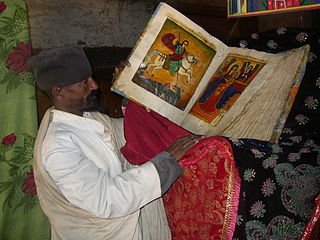
The Orthodox Tewahedo biblical canon is a version of the Christian Bible used in the two Oriental Orthodox churches of the Ethiopian and Eritrean traditions: the Ethiopian Orthodox Tewahedo Church and the Eritrean Orthodox Tewahedo Church. At 81 books, it is the largest and most diverse biblical canon in traditional Christendom.
A debtera is an itinerant religious figure in the Ethiopian and Eritrean Orthodox Tewahedo Churches, and the Beta Israel, who sings hymns and dances for churchgoers, and who performs exorcisms and white magic to aid the congregation. A debtera will claim an ecclesiastical identity and behave as in minor orders. They may in fact be officially ordained as deacons, or may act outside the Church hierarchy. They are usually feared by the local population.
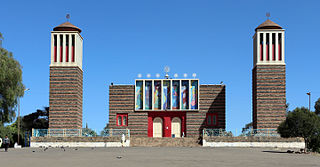
The Eritrean Orthodox Tewahedo Church is one of the Oriental Orthodox Churches with its headquarters in Asmara, Eritrea. Its autocephaly was recognised by Pope Shenouda III of Alexandria, Pope of the Coptic Orthodox Church, after Eritrea gained its independence from Ethiopia in 1993. Thus, the Eritrean Church accords a primacy of honor to the Coptic Church.
Kay Kaufman Shelemay is the G. Gordon Watts Professor of Music and Professor of African and African American Studies at Harvard University. She received her PhD in Musicology from the University of Michigan and won a Guggenheim Fellowship in 2007. Shelemay was elected to the American Philosophical Society in 2013.
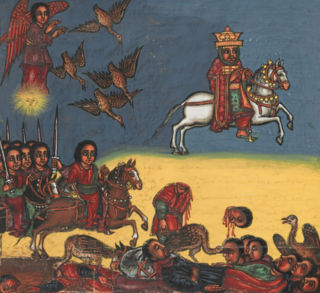
The history of Ethiopia in the Middle Ages roughly spans the period from the decline of the Kingdom of Aksum in the 7th century to the Oromo migrations beginning in the mid-16th century. Aksum had been a powerful empire during late antiquity, appearing in the Periplus of the Erythraean Sea and mentioned by Iranian prophet Mani as one of the "four great kingdoms on earth", along with the Sasanian Empire of Persia, the Roman Empire, and China's Three Kingdoms. The kingdom was an integral part of the trade route between Rome and the Indian subcontinent, had substantial cultural ties to the Greco-Roman world, and was a very early adopter of Christianity under Ezana of Aksum in the mid-4th century. The use of "Ethiopia" to refer to the region dates back to the 4th century. At its height, the kingdom spanned what is now Eritrea, northern Ethiopia, eastern Sudan, Yemen and the southern part of what is now Saudi Arabia. However, by the 7th century, the kingdom had begun a slow decline, for which several possible political, economic, and ecological reasons have been proposed. This decline, which has been termed the "Post-Aksumite Period", saw extreme loss of territory and lasted until the ascension of the Zagwe dynasty.

Orthodox Tewahedo music refers to sacred music of the Ethiopian and Eritrean Orthodox Tewahedo Church. The music was long associated with Zema (chant), developed by the six century composer Yared. It is essential part of liturgical service in the Church and classified into fourteen anaphoras, with the normal use being the Twelve Apostles.

The Book of Deggua is a hymnary guideline of the Ethiopian and Eritrean Orthodox Tewahedo Churches written by the six century composer Yared. The great Deggua is called Mahlete Yared (treasury).
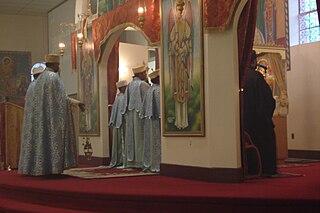
Kidase is an Orthodox Tewahedo daily worship service originated by the sixth century Aksumite composer Saint Yared hymnary works. The word "Kidase" means thanksgiving to the Lord by mankind and angels alike, which has a purpose of converting the wine and bread into the Holy Sacrament, as this day is eve of Jesus crucifixion.
